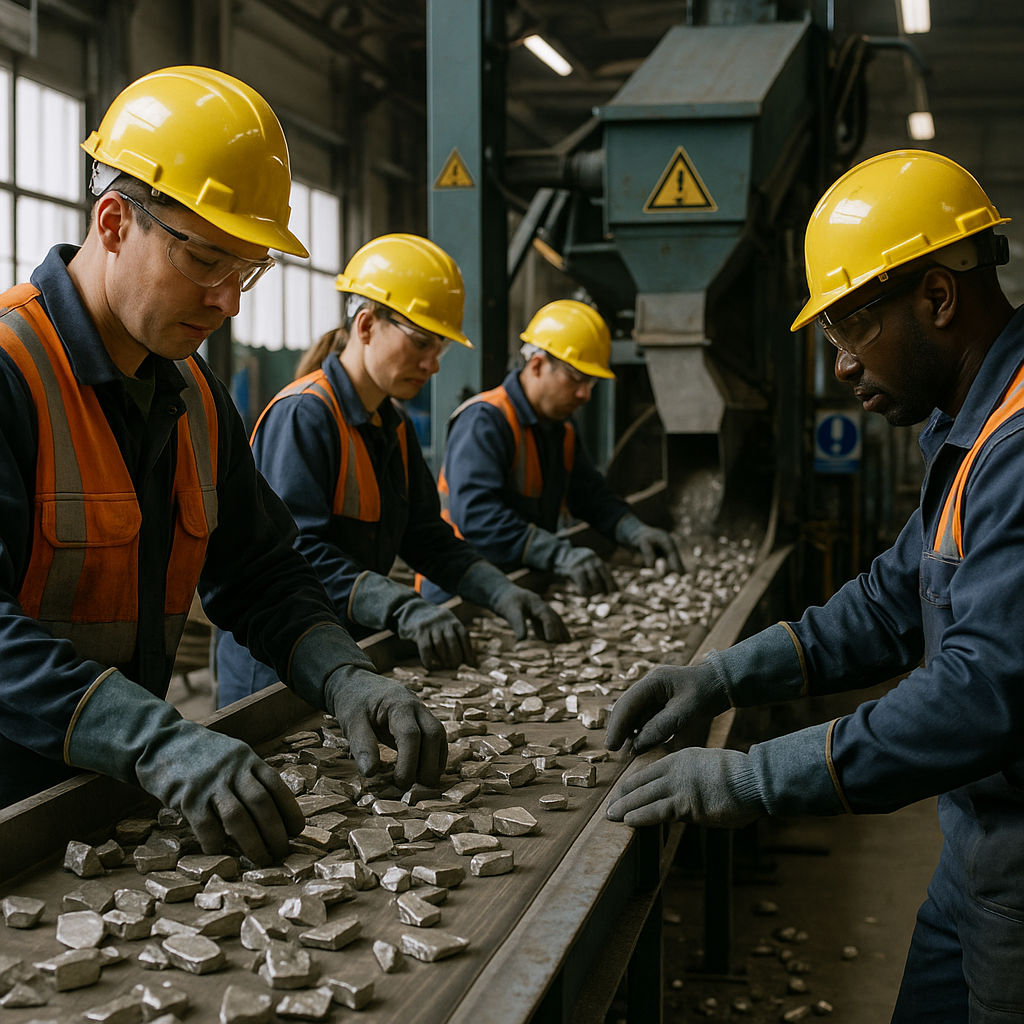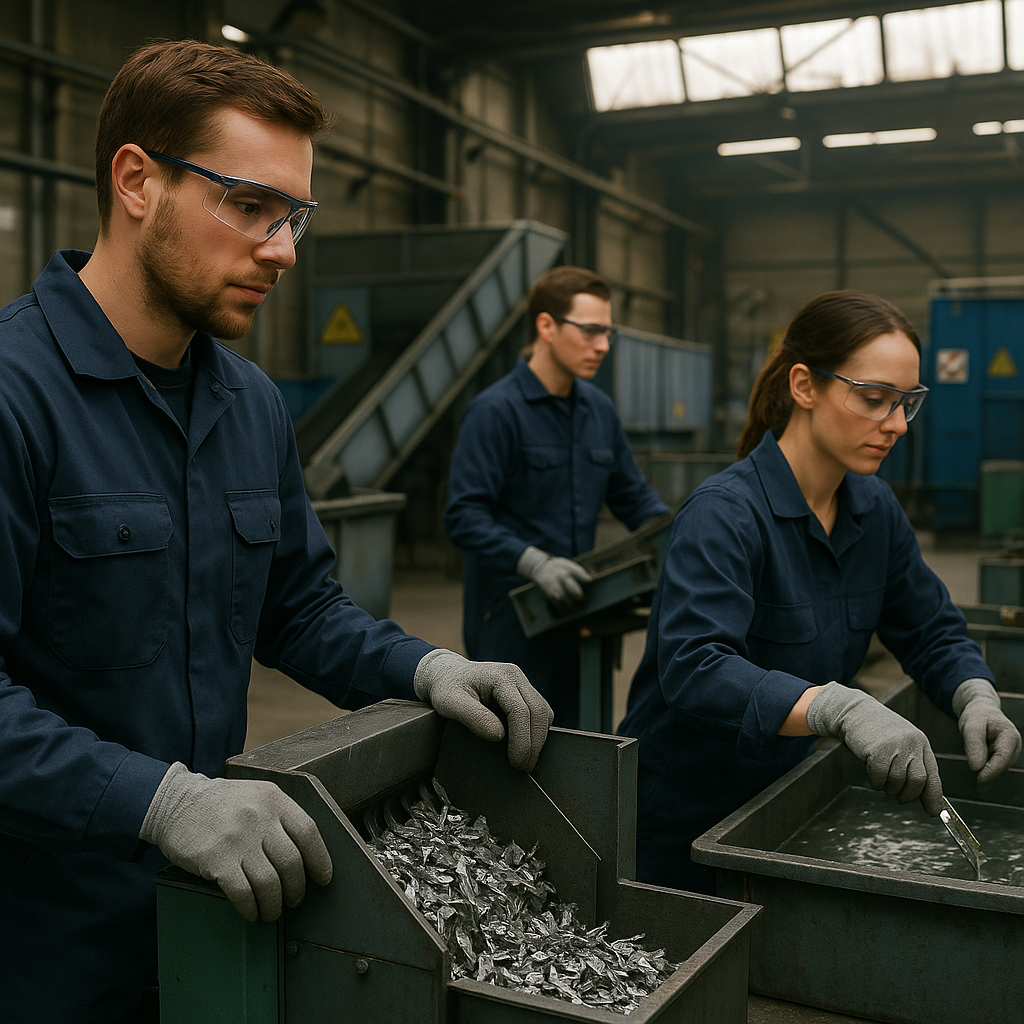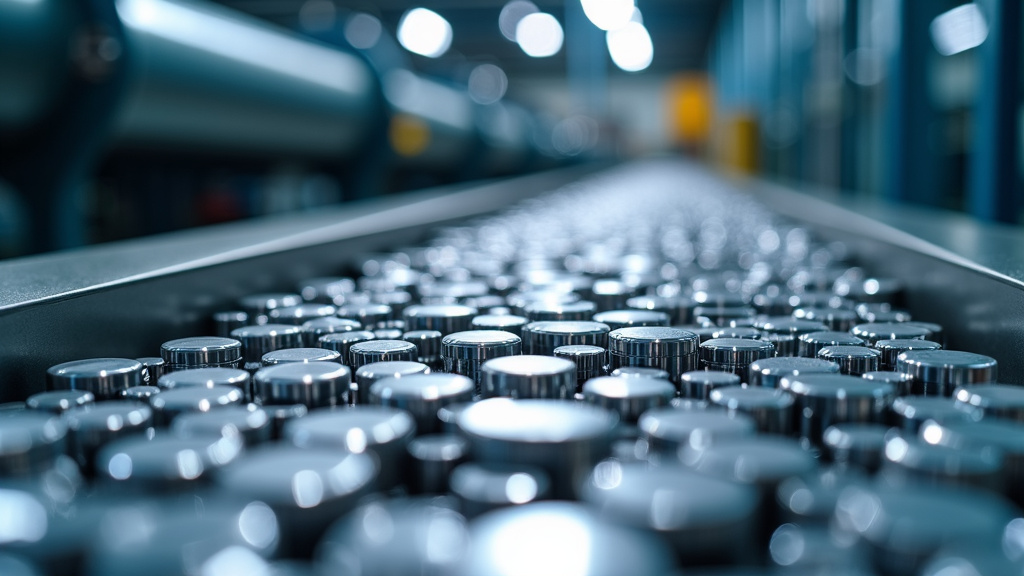5901 Botham Jean Blvd, Dallas, TX 75215
Nickel Recycling Process: Key Methods, Benefits, Challenges, and Future Trends
October 8, 2025Nickel recycling involves the systematic recovery and reuse of nickel from discarded products and waste materials. This valuable metal is collected from various sources, sorted by composition, and processed to extract pure nickel for reuse in manufacturing. The process transforms potential waste into a valuable resource.
The nickel recycling journey begins with collection from industrial scrap, electronic waste, and end-of-life products like batteries and stainless steel items. Once collected, these materials undergo careful sorting using techniques such as magnetic separation, color identification, and advanced technologies like X-ray fluorescence analysis.
This recycling effort delivers significant benefits. It conserves finite natural resources by reducing the need for mining virgin nickel ore and uses substantially less energy than extracting new nickel. Additionally, it creates economic opportunities through job creation and provides manufacturers with cost-effective raw material alternatives.
What Are the Key Steps in Nickel Recycling?

Nickel recycling involves a sophisticated process that transforms end-of-life products into valuable reusable materials. This process not only conserves natural resources but also reduces the environmental impact associated with primary nickel production. The following steps illustrate how nickel recycling achieves efficiency and effectiveness.
Collection and Sorting
The recycling process begins with gathering nickel-containing materials from various sources, including industrial scrap, end-of-life products, electronic waste, and manufacturing remnants. Once collected, these materials undergo precise sorting to separate nickel-rich items from other waste.
Modern recycling facilities utilize advanced identification technologies to enhance sorting accuracy. X-ray fluorescence (XRF) analyzers quickly identify metal composition without damaging the materials. Similarly, laser-induced breakdown spectroscopy (LIBS) aids in detecting and separating different nickel alloys with remarkable precision.
Shredding and Size Reduction
After sorting, nickel-containing materials are shredded into smaller pieces. This crucial step increases the surface area of the materials, making subsequent processing more efficient. Industrial shredders and crushers break down bulky items into manageable fragments.
Size reduction also liberates nickel from other materials it might be bonded with. This process creates a more uniform feed material for later stages, improving overall recovery rates.
Magnetic Separation
The shredded materials then undergo magnetic separation to remove ferrous (iron-containing) materials. Strong magnets pull out steel and other iron-based components, leaving behind non-ferrous metals, including nickel.
For nickel-containing stainless steel, which is partially magnetic, specialized equipment with varying magnetic field strengths achieves more precise separation. This step is crucial for purifying the material stream before chemical processing.
Chemical or Thermal Treatment
Separating nickel from other non-ferrous metals requires either chemical or thermal treatment. In hydrometallurgical processes, chemical leaching agents selectively dissolve nickel, creating a solution from which pure nickel can later be recovered. These techniques target nickel specifically while minimizing the dissolution of unwanted metals.
Alternatively, pyrometallurgical methods use high temperatures to melt and separate metals based on their different melting points. Modern facilities often employ energy-efficient furnaces and integrate renewable energy sources to reduce the carbon footprint of this energy-intensive step.
Refining and Purification
The final step transforms the recovered nickel into high-quality material ready for reuse. Electrowinning processes apply an electrical current through a solution containing dissolved nickel, causing pure nickel to deposit onto cathodes. Alternatively, chemical precipitation methods can produce nickel compounds of varying purity levels.
Quality control measures ensure the recycled nickel meets industry specifications. The end product can achieve purity levels comparable to newly mined nickel, making it suitable for high-performance applications in aerospace, automotive, and battery manufacturing.
Through these sophisticated processes, nickel recycling facilities can recover up to 68% of available nickel from consumer products. The remaining material typically enters other recycling streams or, unfortunately, ends up in landfills. As technology advances and collection systems improve, the efficiency of nickel recycling continues to increase, contributing to more sustainable resource management.
What Are the Different Methods Used in Nickel Recycling?

Nickel recycling utilizes various methods to recover this valuable metal from spent batteries and other waste. Each method has unique advantages and operates on different principles. Here are the four main techniques used in modern nickel recycling.
Pyrometallurgical Processes
Pyrometallurgical recycling employs intense heat to extract and separate metals, operating at temperatures between 1200°C and 1600°C in specialized furnaces. The heat transforms nickel compounds, separating them from other materials.
The process involves three steps: first, roasting heats materials in air, transforming metal compounds into oxides; next, smelting uses high temperatures to reduce metals, separating them from other compounds; finally, refining sorts metals based on chemical properties.
While pyrometallurgy effectively recovers metals like nickel and cobalt, it has limitations, including significant carbon emissions—up to 361 tons of CO2 per kilogram of recovered metal. Additionally, materials such as lithium often end up in slag and aren’t recovered, making this method less environmentally friendly than some alternatives.
Hydrometallurgical Techniques
Hydrometallurgy uses water-based chemical processes to dissolve and recover metals. This method has gained popularity due to its efficiency and lower environmental impact.
The process starts with leaching, where acid solutions, usually dilute sulfuric acid, dissolve metal compounds from crushed materials. Then, solution-based concentration and purification extract specific metals. Finally, metal recovery produces nickel salts suitable for reuse in new batteries.
Hydrometallurgy offers several advantages over pyrometallurgy; it recovers a broader range of elements, including nickel, lithium, and manganese, consumes less energy, and generates minimal greenhouse gas emissions. Advanced systems can operate with zero wastewater discharge, reducing environmental impact further.
Direct Recycling Methods
Direct recycling aims to preserve the chemical structures of battery materials rather than completely breaking them down. This approach focuses on recovering cathode materials containing nickel without destroying their functional properties.
In direct recycling, batteries undergo mechanical separation to isolate cathode materials. The process then cleans and rejuvenates these materials through mild chemical treatments. Preserving the chemical structure requires less energy and reduces environmental impact.
Research indicates that direct recycling achieves higher material recovery rates and lower processing costs than traditional methods. However, it is less commercially adopted than pyrometallurgy and hydrometallurgy, though its use is growing as the technology advances.
Biological Recycling Methods
Biological recycling is an emerging area using microorganisms to extract metals from waste materials. Though still developing, this approach offers a potentially more sustainable alternative to chemical methods.
The process employs specific bacteria or fungi strains to extract nickel from waste. Some fungi produce organic acids that dissolve and separate nickel compounds, essentially performing a natural leaching process that requires fewer harsh chemicals and less energy.
Research is focused on optimizing bacterial and fungal strains for effective recovery of specific metals from battery waste, showing promising results for metals like nickel and cobalt. While bio-recycling faces challenges like material complexity and process efficiency, it holds significant potential for environmentally friendly metal recovery.
As recycling technologies evolve, these methods are becoming more efficient and sustainable. Integrated approaches combining multiple techniques often yield the best results, maximizing resource recovery while minimizing environmental impact.
| Recycling Method | Key Features | Environmental Impact | Recovery Rate |
|---|---|---|---|
| Pyrometallurgical Processes | High temperatures (1200°C-1600°C), melting and refining | High carbon emissions, up to 361 tons CO2/kg recovered metal | Effective for nickel and cobalt |
| Hydrometallurgical Techniques | Water-based chemical processes, acid leaching | Lower energy use, minimal waste discharge | Recovers nickel, lithium, manganese |
| Direct Recycling Methods | Preserves chemical structure of cathodes | Less energy-intensive | Higher recovery rates compared to traditional methods |
| Biological Recycling Methods | Use of microorganisms, natural leaching | Low environmental impact | In early development stages, promising results for nickel and cobalt |
What Are the Benefits and Challenges of Nickel Recycling?
Nickel recycling is a key element of sustainable resource management, providing significant environmental and economic benefits. With approximately 68% of nickel from consumer products being recycled, the industry has made notable progress in developing closed-loop systems. This recycling rate reflects the metal’s importance in the circular economy and illustrates the effectiveness of current recovery methods.
Environmental Benefits of Nickel Recycling
A primary benefit of nickel recycling is resource conservation. By recovering nickel from end-of-life products, the need for mining virgin materials is considerably reduced. This helps preserve landscapes that would otherwise be impacted by mining operations, protecting habitats and biodiversity.
Another critical advantage of nickel recycling is the reduction of carbon emissions. Recycling nickel requires far less energy compared to producing it from ore. For example, using recycled nickel can cut carbon dioxide emissions by up to 90% compared to producing primary nickel. This substantial reduction aids global efforts to combat climate change by lowering greenhouse gas emissions.
Energy efficiency is also a major environmental benefit. Processing recycled nickel consumes significantly less energy than extracting and refining new materials. Some studies show that recycling nickel can save between 65% and 95% of the energy needed for primary production, depending on the specific recycling process and the type of material.
Economic and Social Benefits
Nickel recycling also offers considerable economic advantages. The industry generates jobs throughout the recycling chain, from collection and sorting to processing and manufacturing. In the United States alone, the scrap metal recycling sector supports over 450,000 jobs, with nickel recycling being a crucial component of this workforce.
Recycling also helps stabilize material supply chains by lessening dependence on imports and reducing the price volatility associated with raw material extraction. As demand for nickel grows, especially for use in clean energy technologies and electric vehicle batteries, recycled nickel will increasingly meet market needs.
Challenges in Nickel Recycling
Despite its benefits, nickel recycling faces several challenges. Properly identifying and sorting nickel-containing materials is a major hurdle. Nickel is found in various alloys and products, often combined with other metals, making segregation challenging. Advanced sorting technologies are essential but can be costly to implement, particularly for smaller operations.
The complexity of nickel alloys presents additional difficulties. High-performance applications often involve specialized nickel alloys containing multiple elements in precise proportions. Efficiently separating these components while retaining their value requires sophisticated processes. For example, nickel used in superalloys for aerospace applications contains specific amounts of elements like cobalt and chromium, which can be difficult to isolate during recycling.
Contamination is another significant challenge. Impurities in scrap can compromise the quality of recycled nickel. Materials like oil, paint, coatings, and other non-metallic substances must be removed before processing. Even minimal amounts of certain elements can affect the properties of recycled nickel, potentially limiting its applications or requiring further refinement.
The energy needed to recycle complex nickel-bearing materials can be significant. Although recycling generally uses less energy than primary production, processing low-grade materials or complex alloys may require energy-intensive techniques, diminishing the environmental benefit if that energy comes from non-renewable sources.
Technological Solutions and Innovations
The recycling industry is developing innovative solutions to tackle these challenges. Advanced sorting technologies utilizing sensors, artificial intelligence, and machine learning are improving material identification. Hydrometallurgical processes are being refined to separate nickel from complex alloys with a reduced environmental impact.
For instance, companies like Umicore combine pyro and hydrometallurgical technologies to process battery materials efficiently. Their industrial-scale operation can process 7,000 tons of material annually, dismantling complex battery modules without hazardous pre-treatment steps. These processes recover valuable metals, including nickel, cobalt, copper, and lithium, while minimizing energy use and CO2 emissions.
Similarly, companies such as Li-Cycle Corp. have created proprietary processes to meet the rising demand for battery recycling. Their two-step hydrometallurgical resource recovery process can obtain nickel in the form of nickel sulfate, usable by the battery industry without further processing steps.
As global demand for nickel continues to rise, especially in renewable energy and electric vehicles, improving recycling rates and efficiency becomes crucial. The industry must invest in technological innovation and infrastructure development to overcome current challenges and maximize resource recovery.
The journey towards more efficient nickel recycling will require collaboration among producers, consumers, recyclers, and policymakers. With ongoing focus and investment, nickel recycling can contribute to a more sustainable and resource-efficient future while meeting the growing demand for this versatile and valuable metal.
What is the Future of Nickel Recycling?

The future of nickel recycling is at a pivotal point. The transition to clean energy is significantly increasing the demand for nickel in electric vehicle batteries and renewable energy storage systems. This surge presents both challenges and opportunities for the recycling industry. Current estimates suggest that up to 68% of nickel from consumer products is already being recycled, yet 17% still ends up in landfills.
Technological innovations are reshaping nickel recycling. Advanced AI-powered sorting systems can now identify and separate different metal types with greater precision. Additionally, more efficient extraction processes using hydrometallurgical and pyrometallurgical techniques are emerging, allowing for higher recovery rates from complex products like EV batteries.
The circular economy model is gaining momentum in nickel recycling. This approach emphasizes keeping materials in use longer through reuse, remanufacturing, and recycling. For nickel, this involves designing products for easier disassembly and recycling, creating closed-loop supply chains, and developing new business models that treat end-of-life products as valuable resources rather than waste.
If you have nickel-containing materials that require proper recycling or you want to learn more about sustainable metal management solutions, contact Okon Recycling at 214-717-4083.
